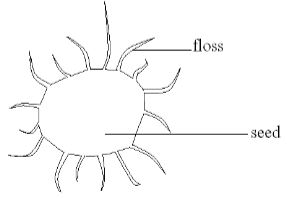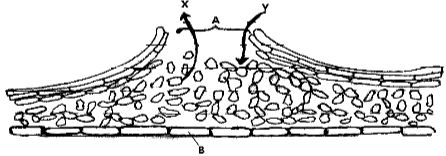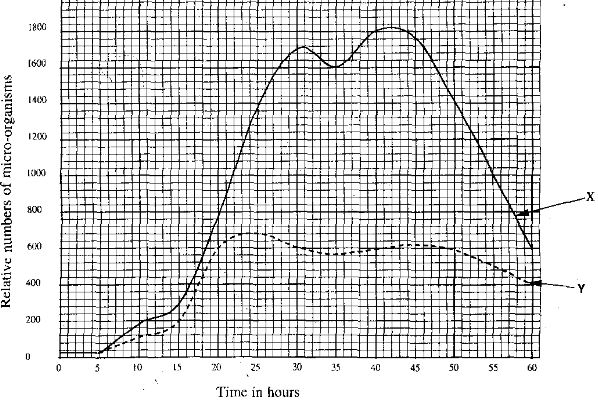Questions
Instructions to candidates
- Answer all the questions In section A in the spaces provided
- In section B, answer question 6 [compulsory] and either question 7 or 8 in the spaces provided after question 8
Section A [40 marks]
-
- What is meant by the term sex linked genes? [1 mark]
- Name two sex linked traits in humans. [2 marks]
- In Drosophila melanongaster, the inheritance of the eye colour is sex linked. The gene for red eye is dominant. A cross was made between a heterozygous red eyed female and a white eyed male. Work out the phenotypic ratio of F1 generation. [Use R to represent the gene for red eye colour. [5 marks]
- The diagram below represents a mature fruit of a certain plant.
- State the agent for dispersal for the fruit. [1 mark]
- Give a reason for your answer in [a] above. [2 marks]
- State two characteristics of fruits and seeds dispersed by the agent you named in [a] above. [2 marks]
- What are the advantages of fruit and seed dispersal? [2 marks]
- State one importance of fruits in the survival of plants. [1 mark]
- What are vestigial structures? Give an example in human beings. [2 marks]
- How do vestigial structures act as evidence that evolution has taken place? [1 mark]
- The peppered moth Biston betularia exists in many parts of England. It normally rests on barks of trees. It exists in two major forms; a normal or wild type which is speckled white and a mutant variety which is darker [melanic form]. Before industrialization almost all the peppered moth in England were of white variety. After 1840s the population of the melanic form increased rapidly especially around the industrial cities. The white form dominated in the rural non polluted areas.
- Explain why mutant [melanic] form is dominated in the industrial [polluted] areas. [2 marks]
- Discuss why the lighter [non melanic] form is dominated in rural [non polluted] areas. [2 marks]
- What factor could have led to the differences in population size of the two varieties in the two areas? [1 mark]
- State the advantages of natural selection. [2 marks]
- The diagram below represents a structure used for gaseous exchange in a woody plant.
- Name the part labeled A and B. [2 marks]
A……………………………………………………………………………………
B…………………………………………………………………………………… - Name the gases marked by arrows X and Y. [2 marks]
X……………………………………………………………………………………
Y…………………………………………………………………………………… - Give the function of the part labeled B. [1 mark]
- Name the physiological process that results in the production of gas X in the plant tissues. [1 mark]
- Why does low oxygen concentration in the soil result in reduced mineral absorption by root hair of plants? [2 marks]
- Name the part labeled A and B. [2 marks]
- The following experiment was set up by a form one class. After an hour, the contents of the visking tubing and the beaker were tested using both iodine solution and benedict’s solution each at a time.
Record in the table below the expected observations after the contents in set up A and B were tested using iodine solution and benedict’s solution. [8 marks]
Visking tubing Beaker Set up iodine solution Benedicts solution Iodine solution Benedict's solution
A
B
SECTION B [40 MARKS]
Answer question 6 (compulsory) and either question 7 or 8.
- An experiment to investigate the population of a certain type of micro-organism was carried out. Two Petri-dishes labeled X and Y were used. Into the Petri-dish labeled X, 60ml of a culture medium was added while 15ml of the same culture medium was placed in the Petri-dish labeled Y. Equal numbers of micro-organisms were introduced in both Petri-dishes. The set-ups were incubated at 35°C. The number of micro-organisms in each petri-dish was determined at regular intervals for a period of 60 hours. The results were as shown in the graph below.
- At what intervals were the numbers of micro-organisms determined. [1 mark]
- After how many hours was the population in each petri-dish highest? Indicate the population in each case
Petri-dish X:…………………………………………………………[2 marks]
Time………………………………………………………………………………….
Population:…………………………………………………………………………..
Petri-dish Y:……………………………………………………………[2 marks]
Time………………………………………………………………………………….
Population:………………………………………………………………………….. - After how many hours was the difference in the two populations greatest? [1 mark]
- Account for the shape of curve Y between.
- 0 – 5 hours [2 marks]
- 5 - 25 hours [2 marks]
- 25 – 50 hours [2 marks]
- Account for the high numbers of micro-organisms in petri-dish X after 25 hours. [2 marks]
- With reasons give the effects on the population of micro-organisms if after 10 hours the petri-dishes were kept at;
- 10°C
Reason [2 marks] - 60°C
Reason [2 marks]
- 10°C
- Describe how the mammalian eye is adapted to its functions. [20 marks]
-
- Explain how plants can eliminate metabolic waste products. [8 marks]
- Explain why plants have less specialized excretory organs as compared to animals. [5 marks]
- How is the kidney adapted to perform its function? [7 marks]
Download Biology Paper 2 Questions - Mathioya Mock Exams 2022.
Tap Here to Download for 50/-
Get on WhatsApp for 50/-
Why download?
- ✔ To read offline at any time.
- ✔ To Print at your convenience
- ✔ Share Easily with Friends / Students




